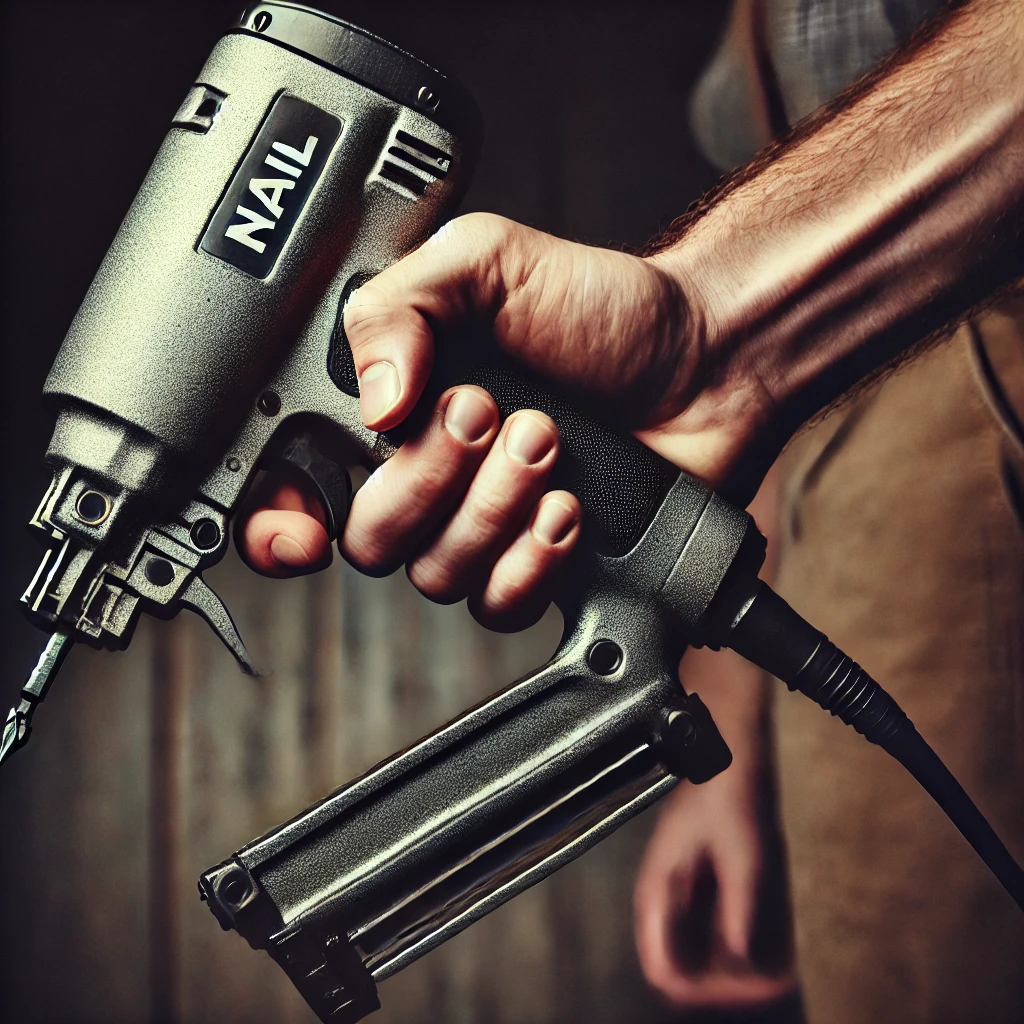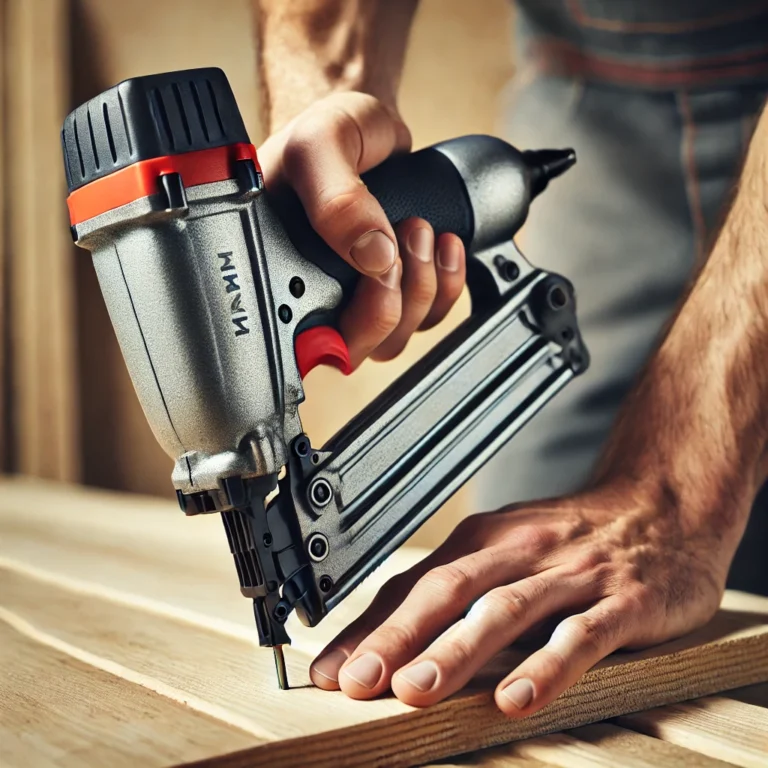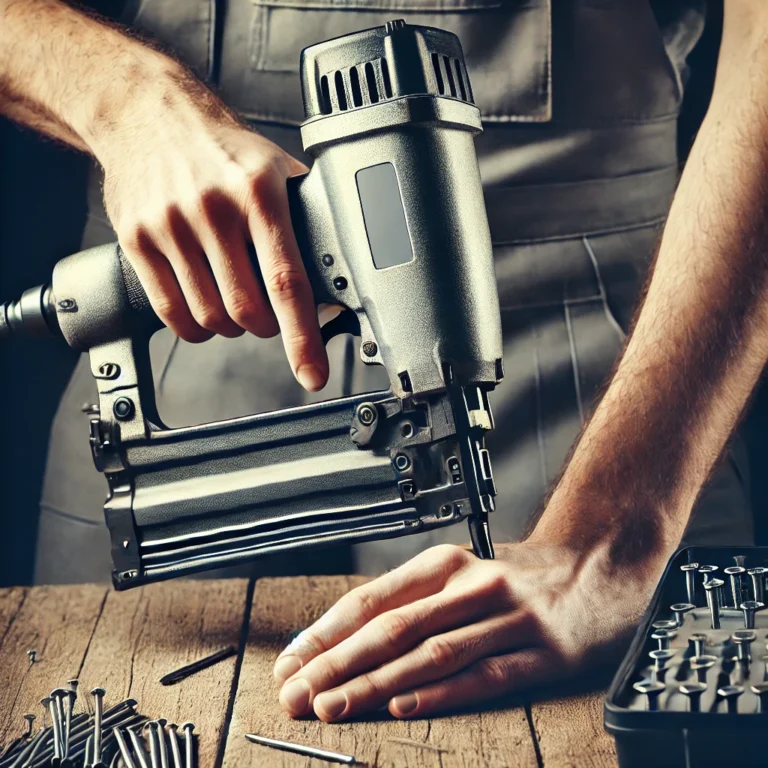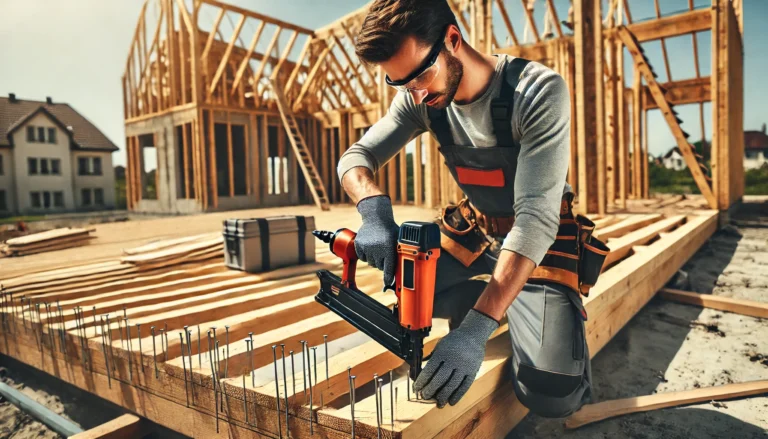The 9 Main Types of Nail Guns – And How to Use Them
Nail guns are designed for one specific purpose: to drive nails into wood (and other materials). This simple power tool replaces the hammer and nails, and it drives nails much faster than its manual counterpart.
Those who have no experience with nail guns may feel a little overwhelmed when purchasing one in the store. As it turns out, there are several different types of nail guns, and each one has its own unique use.
1. FRAMING NAILER
Framing nailers are the heaviest duty nailer, and their name is fitting. These nailers are ideal for use on wood framing in heavy construction jobs and building.
A framing nailer can work with nails up to 3-1/2,” which are used to join 2×4’s. They’re often used to build:
- Decks.
- Rooms.
- Homes.
- Wood sheathing.
- Fences.
- Wood siding.
Many models have interchangeable sequential and contact trip as well as tool-free depth-drive adjustment.
There are two types of framing nailers: round head and clipped head. Clipped head nailers are ideal for high volume projects because they can hold more nails.
Round head framing nailers are not restricted by certain building codes, but hold fewer nails.
2. FLOORING NAILER
Flooring nailers look very different than the typical nail guns most people are used to seeing. These nailers are uniquely designed to make quick work of laying tongue-and-groove floorboards.
The nailer is held at the edge of the board, and a nylon mallet is used to hit the plunger. This method ensures that nails (or cleats) are driven at the right angle and depth every single time.
There are two types of flooring nailers: pneumatic and manual. Both are used in similar ways, but pneumatic nailers use air pressure to help drive the nail into the floorboard. Pneumatic flooring nailers require less human exertion.
Flooring nailers aren’t as versatile as other nailers, in that they don’t have any other use aside from laying floorboards.
2. FLOORING NAILER
Flooring nailers look very different than the typical nail guns most people are used to seeing. These nailers are uniquely designed to make quick work of laying tongue-and-groove floorboards.
The nailer is held at the edge of the board, and a nylon mallet is used to hit the plunger. This method ensures that nails (or cleats) are driven at the right angle and depth every single time.
There are two types of flooring nailers: pneumatic and manual. Both are used in similar ways, but pneumatic nailers use air pressure to help drive the nail into the floorboard. Pneumatic flooring nailers require less human exertion.
Flooring nailers aren’t as versatile as other nailers, in that they don’t have any other use aside from laying floorboards.
3. PALM NAILER
Palm nailers are just like mini nail guns. These palm-sized nail guns work in the same way as their full-size counterparts, but on a much smaller scale.
As its name suggests, these nailers rest in the palm of the hand. There’s also a strap that wraps around the hand, so its stays comfortably in place during use.
These nail guns come in pneumatic, electric and cordless variations. Cordless variations, which run on battery, provide more freedom and portability.
Palm nailers are ideal for:
- Tight spots.
- Joist hangers.
- Smaller projects.
There are several advantages to using palm nailers, but one of the main advantages is reduced fatigue. Because these nailers are light and small, they are much easier to work with for longer periods of time.
Unlike other nail guns, which use coils or strips, these guns use regular nails, like what is used with a hammer.
Most palm nailers are capable of driving nails between 1.5″ and 3.5″ long, but there are also heavy-duty models that can drive nails between 2″ and 6″ in length.
Because of their small size, palm nailers are extremely accurate.
These nailers are usually inexpensive and often come for free with larger nail guns.
4. ROOFING NAILER
Roofing nailers are also heavy-duty, much like framing nailers. They are typically only used by professional contractors, although serious DIYers may also have one.
A roofing nailer drives nails into wood or other roofing materials at lightning fast speeds.
There are a few different types of roofing nailers:
- Spring loaded: The simplest roofing nailer, which uses springs to fire nails out of the chamber.
- Pneumatic: Powered by an air compressor, pneumatic roofing nailers are the most popular type of nailer in this category.
- Solenoid: These nailers are powered by electromagnetic polarization.
Like the flooring nailer, the roofing nailer is only used for roofing jobs, and typically only by professional roofers and contractors.
5. SIDING NAILER
A siding nailer is used to install siding. These powerful nailers join thinner pieces of wood or a synthetic material to a wooden mount.
Similar to the framing nailer, the siding nailer is better suited for projects that require larger pieces of wood to be joined.
Siding nailers use shorter nails between 1-1/4″ – 2-1/2″ with wider heads. Some models are compatible with aluminum nails, which makes them a great fit for aluminum siding.
6. PIN NAILER
Pin nailers are generally used for finishing in carpentry projects, and they are the smallest, most delicate finish nailers you can buy. These tools are compatible with 23-gauge headless nails that look like pins.
Pin nails have almost no holding power and are usually used in conjunction with glue or some other type of adhesive. Sometimes, pin nails are used only to hold materials in place until the glue dries.
A pin nailer is generally used for:
- Finishing work in carpentry.
- Crown molding.
- Cabinetry (sometimes).
- Delicate trim pieces.
- Thin veneers.
- Small furniture trim.
Essentially, this nailer would be used in delicate pieces where larger gauge nails might split the wood.
7. BRAD NAILER
Contractors are often split over whether brad or pin nailers are the best option for finishing work. Brad nailers are also used for finishing, but they are compatible with larger nails – 18-gauge.
An 18-gauge nail is still relatively small in the scheme of things, but still a fair bit larger than a pin nail. These nails also have more holding power.
A brad nailer can be used in just about any application that requires a 15- or 16-gauge nail, such as:
- Baseboards.
- Crown molding.
- Trim work, including door and window casings.
Brad nailers are often the go-to choice for contractors looking to finish a job.
8. FINISH NAILER
A finish nailer can also be used for finish carpentry work, and they are designed to be used with specific sized nails.
Finish nailers are often used for:
- Crown molding.
- Baseboards.
A finish nailer differs from a brad or pin nailer in that it can handle larger and bulkier pieces of wood. These nailers are compatible with 15- to 16-gauge finish nails, which are a little bit bigger than a brad nail.
Because finish nails are a little bit bigger, they have more holding power than the brad nail.
9. STAPLE GUN
Staple guns are nothing like any of the other nailers listed above, but can still drive staples (a type of fastener) into a wide range materials.
Staple guns are highly versatile tools, and they can be used for a wide range of applications, including:
- Upholstery: Staple guns are often used to attach a piece of fabric to the frame of a sofa or chair.
- Carpeting: Staples can be used to fix carpeting to floors and even walls for soundproofing.
- Carpentry and Home Repair: Wood and fabric repairs can often be handled by a staple gun, such as fastening boards and panels.
- Construction: Staple guns have also been used for simple household projects, from birdhouses to dog houses.
While a staple gun cannot replace a power nailer in most projects, it does have its place and is a helpful tool to have in the home.
CONCLUSION
Having a better understanding of the types of nailers available will make it easier to select the right one for the job. Generally, the name of the nailer gives a good indication of the type of projects the tool can handle.







